Application of Multi-Species Differential Evolution Algorithm in Sustainable Microgrid Model
Abstract
1. Introduction
- Optimal design and planning of a renewable energy based MG considering various renewable energy technology options and with realistic inputs on their physical, operational, and economic characteristics.
- An MPDE algorithm based on multi-species and multi-optimization strategies is proposed and applied to the SMG model.
- Two MG scheduling strategies are proposed and the capacity optimization results of the four typical days in four seasons under two strategies are analyzed.
2. Distributed Power Output Model
2.1. Wind Turbine Model
2.2. PV Model
2.3. Diesel Generation Model
2.4. Energy Storage Battery
- (1)
- State of charge
- (2)
- Discharge status
3. Economic Model
3.1. Equivalent Annual Equipment Investment Costs
3.2. Environmental Penalties
3.3. Restrictions
4. Solution Method
4.1. Scheduling Strategy
4.2. Proposed Algorithm
- (1)
- After completion of the population initialization process, the fitness value of each individual is calculated and sorted in ascending order;
- (2)
- Mitotic size CS individuals are selected to constitute the parent DP, dominant parent population Af, and the best individuals Gbest of the current iteration time are obtained;
- (3)
- From the concept of cell mitosis, each individual in Af executes the mitosis behavior in order to assemble DP; the number of mitotic division is CS.
- (1)
- Pick the worst individuals Xbad1 and Xbad2 in OP and DP after the mutation and crossover process;
- (2)
- Use the best individuals Gbest for the current iteration to replace Xbad1 and Xbad2.
- Step 1
- Initialization parameters: population size NP, mitotic size CS, maximum number of iterations Gmax, variation constant factor F0;
- Step 2
- Initialize OP with LHS, calculate the fitness values of each individual and arrange them in ascending order;
- Step 3
- Select the best individual Gbest in OP of current iteration times;
- Step 4
- Select the first CS individuals in ascending order of OP to create dominant parent population Af;
- Step 5
- Af carries out mitosis to make up DP At;
- Step 6
- The OP and DP execute mutation and crossover steps respectively to obtain the populations U1 and U2;
- Step 7
- Replace the worst individuals of the two populations with elite retention strategy;
- Step 8
- Implement the picking operation to obtain populations Xnext1 and Xnext2 for U1 and U2;
- Step 9
- Make sure that fitness function values are sorted in ascending order and choose the previous 2 CS individuals to form the next generation of individuals Xnext.
5. Case Study Analysis
6. Conclusions and Future Research
Author Contributions
Funding
Acknowledgments
Conflicts of Interest
References
- Nejabatkhah, F.; Li, Y.W. Overview of Power Management Strategies of Hybrid AC/DC Microgrid. IEEE Trans. Power Electron. 2015, 30, 7072–7089. [Google Scholar] [CrossRef]
- Patrao, I.; Figueres, E.; Garcera, G.; Gonzalez-Medina, R. Microgrid architectures for low voltage distributed generation. Renew. Sustain. Energy Rev. 2015, 43, 415–424. [Google Scholar] [CrossRef]
- Elsied, M.; Oukaour, A.; Gualous, H.; Lo Brutto, O.A. Optimal economic and environment operation of micro-grid power systems. Energy Convers. Manag. 2016, 122, 182–194. [Google Scholar] [CrossRef]
- Fathima, A.H.; Palanisamy, K. Optimization in microgrids with hybrid energy systems—A review. Renew. Sustain. Energy Rev. 2015, 45, 431–446. [Google Scholar] [CrossRef]
- Nosratabadi, S.M.; Hooshmand, R.A.; Gholipour, E. A comprehensive review on microgrid and virtual power plant concepts employed for distributed energy resources scheduling in power systems. Renew. Sustain. Energy Rev. 2017, 67, 341–363. [Google Scholar] [CrossRef]
- Alavi, S.A.; Ahmadian, A.; Aliakbar-Golkar, M. Optimal probabilistic energy management in a typical micro-grid based-on robust optimization and point estimate method. Energy Convers. Manag. 2015, 95, 314–325. [Google Scholar] [CrossRef]
- Hafez, O.; Bhattacharya, K. Optimal planning and design of a renewable energy based supply system for microgrids. Renew. Energy 2012, 45, 7–15. [Google Scholar] [CrossRef]
- Muis, Z.A.; Hashim, H.; Manan, Z.A.; Taha, F.M.; Douglas, P.L. Optimal planning of renewable energy-integrated electricity generation schemes with CO2 reducing target. Renew. Energy 2010, 35, 2562–2570. [Google Scholar] [CrossRef]
- Umeozor, E.C.; Trifkovic, M. Operational scheduling of microgrids via parametric programming. Appl. Energy 2016, 180, 672–681. [Google Scholar] [CrossRef]
- Shi, W.B.; Li, N.; Chu, C.C.; Gadh, R. Real-time Energy Management in Microgrids. IEEE Trans. Smart Grid 2017, 8, 228–238. [Google Scholar] [CrossRef]
- Shi, W.B.; Xie, X.R.; Chu, C.C.; Gadh, R. Distributed Optimal Energy Management in Microgrids. IEEE Trans. Smart Grid 2015, 6, 1137–1146. [Google Scholar] [CrossRef]
- Lu, X.H.; Zhou, K.L.; Yang, S.L. Multi-objective optimal dispatch of microgrid containing electric vehicles. J. Clean. Prod. 2017, 165, 1572–1581. [Google Scholar] [CrossRef]
- Cheng, S.; Su, G.C.; Zhao, L.L.; Huang, T.L. Dynamic dispatch optimization of microgrid based on a QS-PSO algorithm. J. Renew. Sustain. Energy 2017, 9, 045505. [Google Scholar] [CrossRef]
- Nikmehr, N.; Ravadanegh, S.N. Optimal power dispatch of multi-microgrids at future smart distribution grids. IEEE Trans. Smart Grid 2015, 6, 1648–1657. [Google Scholar] [CrossRef]
- Ma, Y.W.; Yang, P.; Guo, H.X.; Wang, Y.W. Dynamic economic dispatch and control of a stand-alone microgrid in Dongao Island. J. Electr. Eng. Technol. 2015, 10, 1432–1440. [Google Scholar] [CrossRef]
- Elattar, E.E. A hybrid genetic algorithm and bacterial foraging approach for dynamic economic dispatch problem. Int. J. Electr. Power Energy Syst. 2015, 69, 18–26. [Google Scholar] [CrossRef]
- Du, Y.; Pei, W.; Chen, N.S.; Ge, X.J.; Xiao, H. Real-time microgrid economic dispatch based on model predictive control strategy. J. Mod. Power Syst. Clean Energy 2017, 5, 787–796. [Google Scholar] [CrossRef]
- Ali, M.Z.; Awad, N.H.; Suganthan, P.N. Multi-population differential evolution with balanced ensemble of mutation strategies for large-scale global optimization. Appl. Soft Comput. 2015, 33, 304–327. [Google Scholar] [CrossRef]
- Guo, S.M.; Yang, C.C. Enhancing differential evolution utilizing eigenvector-based crossover operator. IEEE Trans. Evol. Comput. 2015, 19, 31–49. [Google Scholar]
- Arabas, J.; Biedrzycki, R. Improving evolutionary algorithms in a continuous domain by monitoring the population midpoint. IEEE Trans. Evol. Comput. 2017, 21, 807–812. [Google Scholar] [CrossRef]
- Xu, L.; Ruan, X.B.; Mao, C.X.; Zhang, B.H.; Luo, Y. An improved optimal sizing method for wind-solar-battery hybrid power system. IEEE Trans. Sustain. Energy 2013, 4, 774–785. [Google Scholar]
- Lu, Z.L.; Tang, Y.; Li, J.; Wang, H.; Wang, X.Q. Multi-objective optimal sizing for distributed generation of isolated hybrid microgrid using Markov-based electromagnetism-like mechanism. Proc. CSEE 2017, 37, 1927–1936. [Google Scholar]
- Li, L.L.; Chen, X.D.; Tseng, M.L.; Wang, C.H.; Wu, K.J.; Lim, M.K. Effective power management modeling of aggregated heating, ventilation, and air conditioning loads with lazy state switching. J. Clean. Prod. 2017, 166, 844–850. [Google Scholar] [CrossRef]
- Li, L.L.; Cheng, P.; Lin, H.C.; Dong, H. Short-term output power forecasting of photovoltaic systems based on the deep belief net. Adv. Mech. Eng. 2017, 9. [Google Scholar] [CrossRef]
- Li, L.L.; Lin, G.Q.; Tseng, M.L.; Tan, K.; Lim, M.K. A Maximum Power Point Tracking Method for PV System with Improved Gravitational Search Algorithm. Appl. Soft Comput. 2018, 65, 333–348. [Google Scholar] [CrossRef]
- Ding, M.; Wang, B.; Zhao, B.; Chen, Z.N. Configuration optimization of capacity of standard PV-wind-diesel-battery hybrid microgrid. Power Syst. Technol. 2013, 37, 575–581. [Google Scholar]
- Ma, P.; Zhou, Y.C.; Shang, X.B.; Yang, M. Firing accuracy evaluation of electromagnetic railgun based on multicriteria optimal Latin Hypercube design. IEEE Trans. Plasma Sci. 2017, 45, 1503–1511. [Google Scholar] [CrossRef]
- The National Centers for Environmental Information. Available online: https://www.ncdc.noaa.gov/ (accessed on 28 November 2017).
- Mirjalili, S.; Mirjalili, S.M.; Lewis, A. Grey wolf optimizer. Adv. Eng. Softw. 2014, 69, 46–61. [Google Scholar] [CrossRef]
- Gandomi, A.H.; Yang, X.S.; Alavi, A.H. Cuckoo search algorithm: A metaheuristic approach to solve structural optimization problems. Eng. Comput. 2013, 29, 17–35. [Google Scholar] [CrossRef]
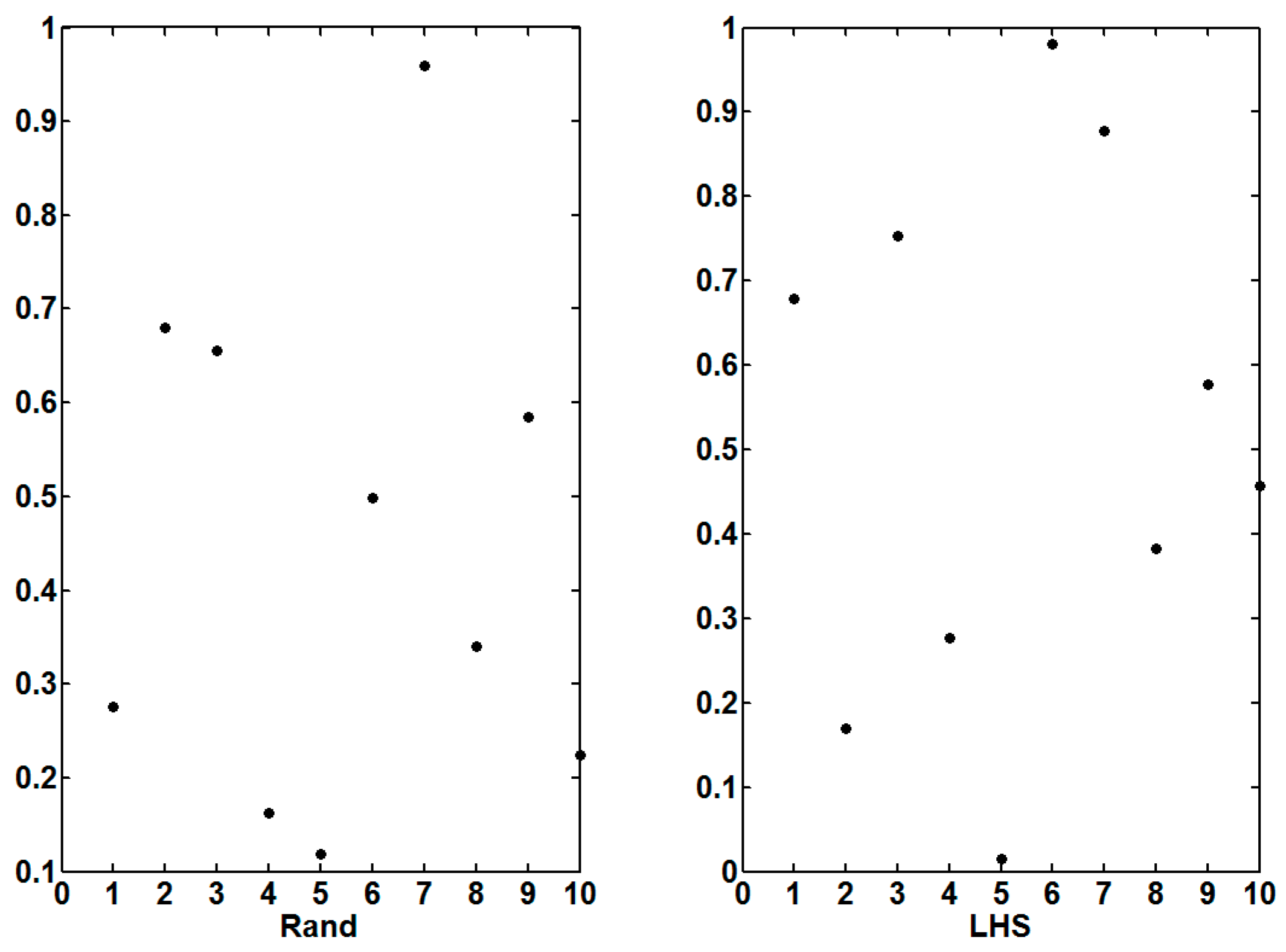
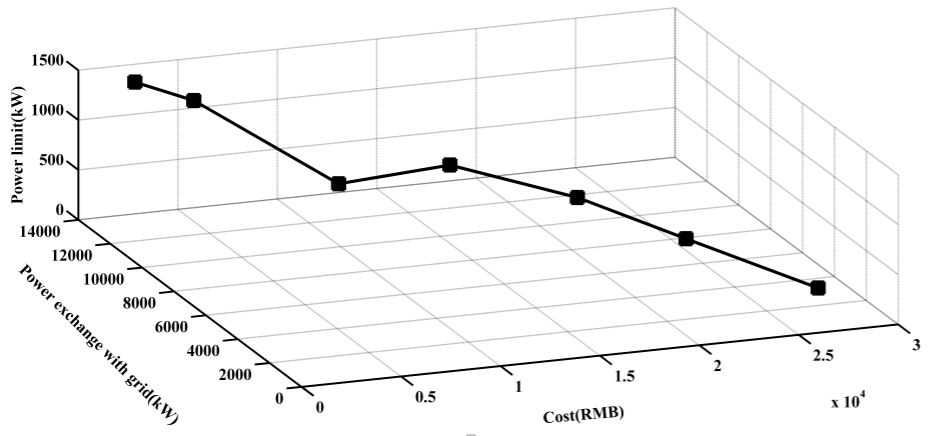

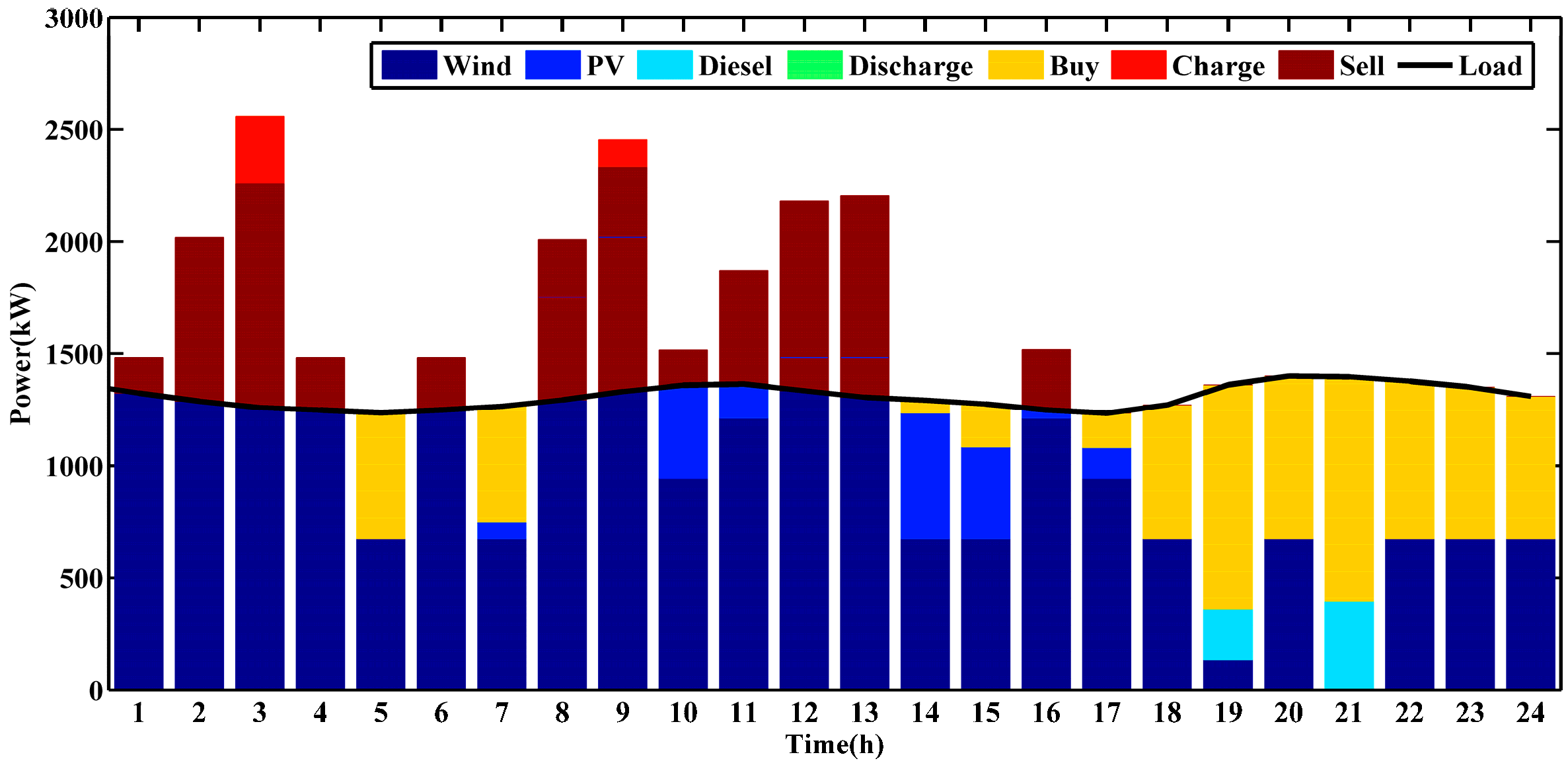
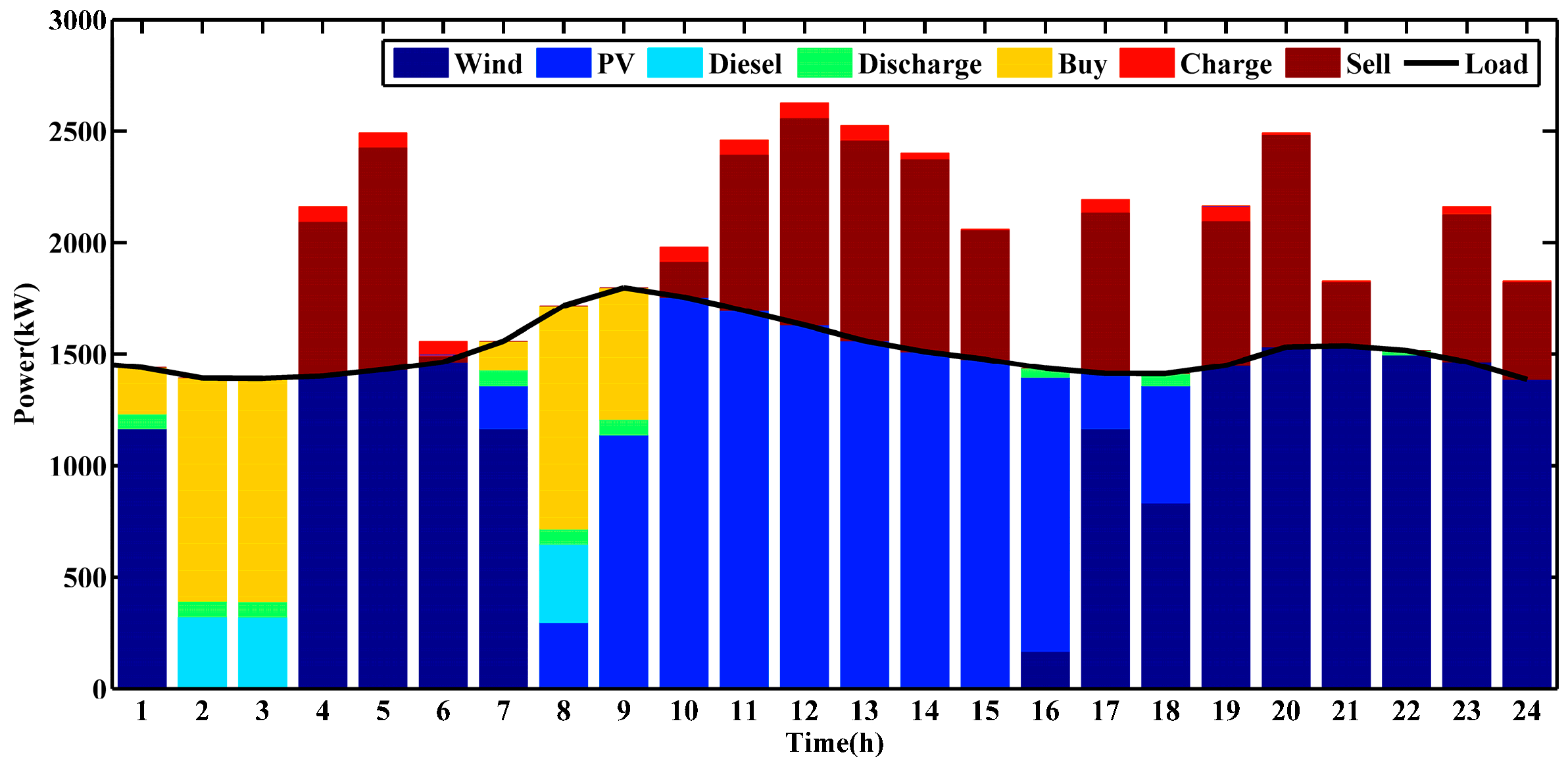



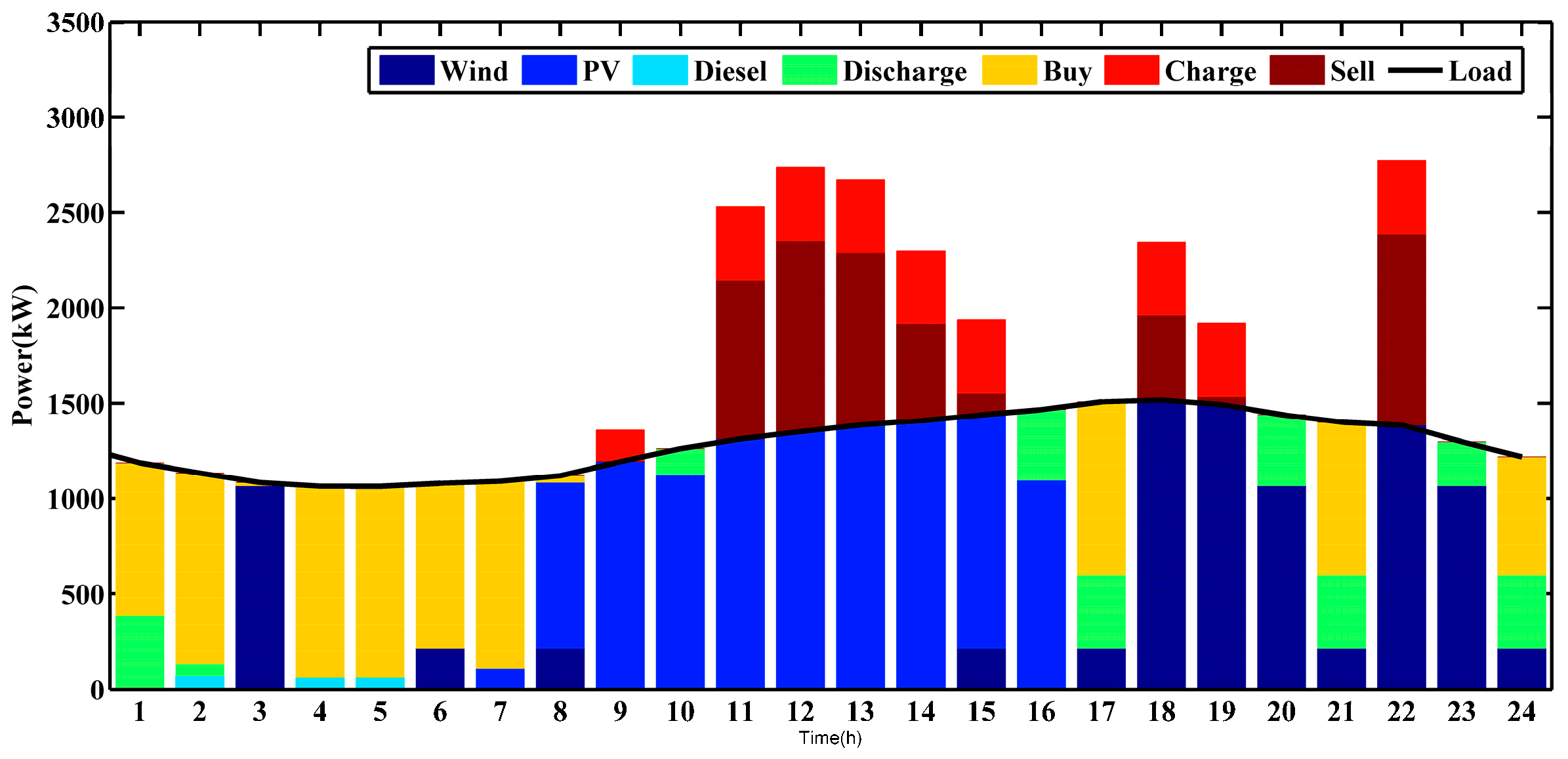
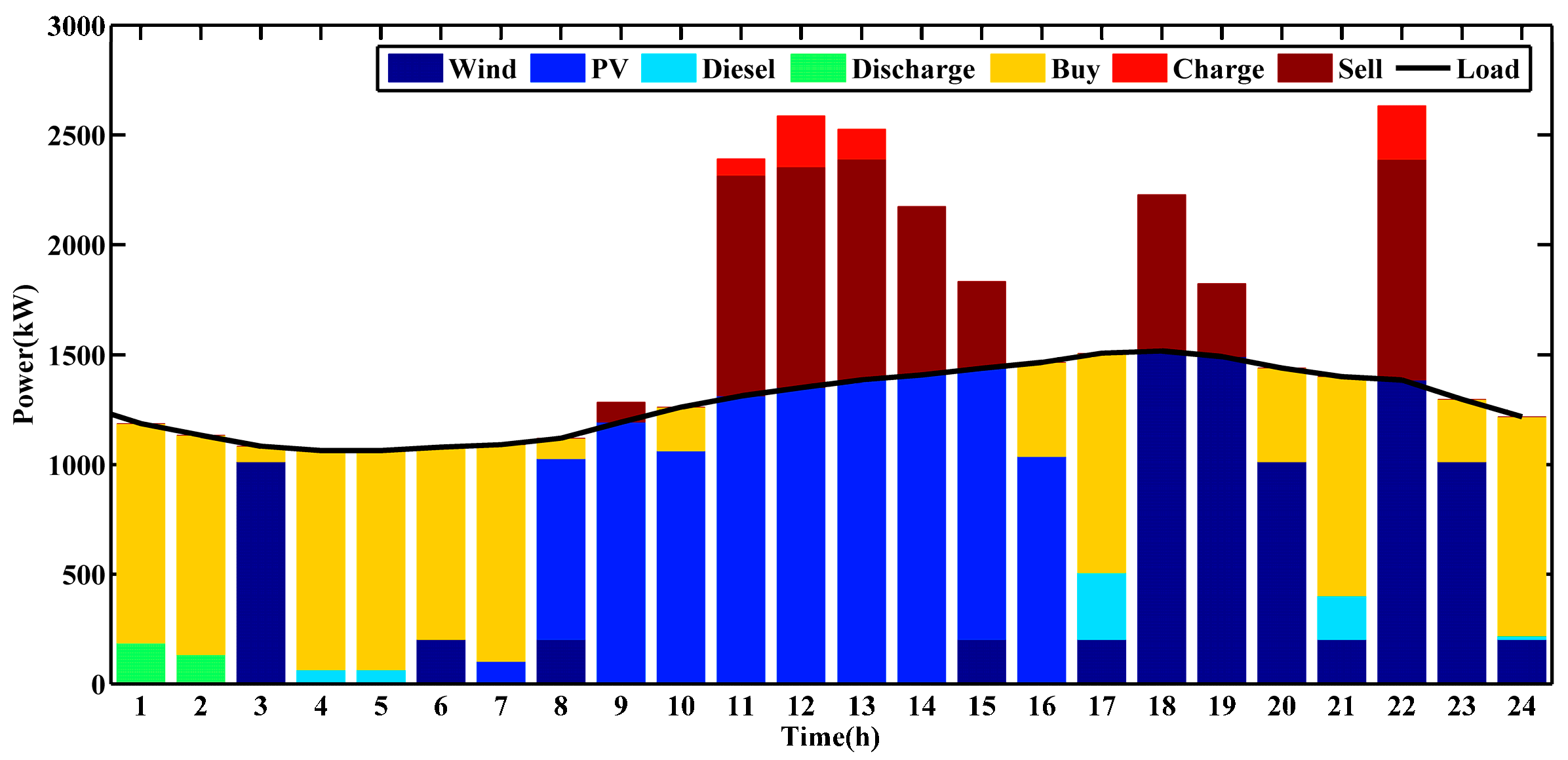

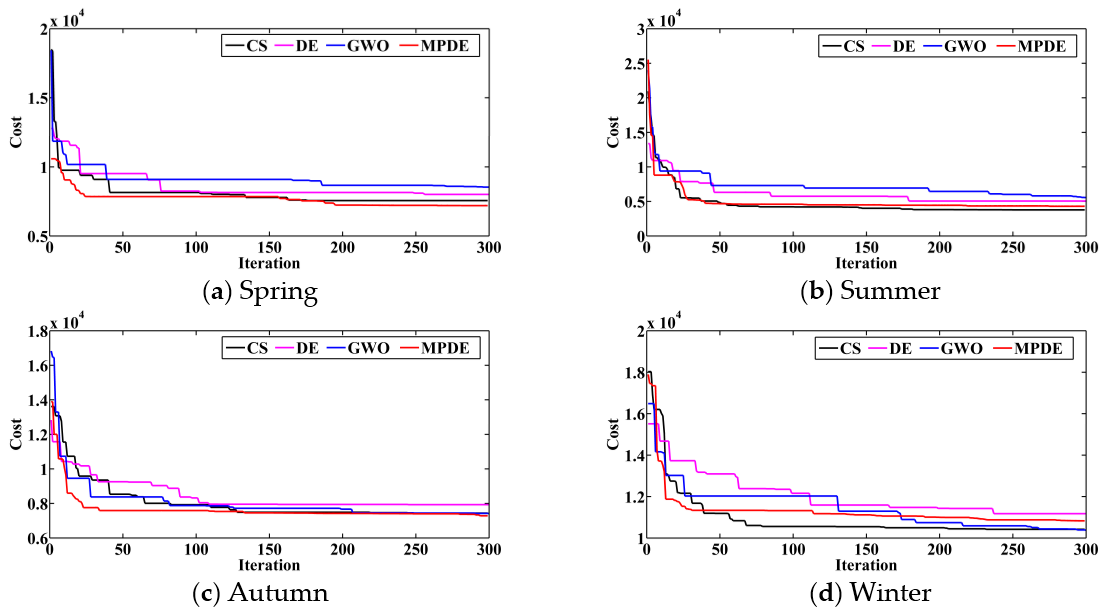
| DG | Wind | PV | Diesel Generation | Battery |
|---|---|---|---|---|
| Cost of investment (RMB/kW) | 4535 | 5000 | 1283 | 567 |
| Replace cost (RMB/kW) | 0 | 0 | 1000 | 453 |
| OM cost (RMB/kW) | 35.4 | 88.7 | 25.7 | 5.7 |
| Capacity (kW) | 25 | 15 | 25 | 5 |
| Life (year) | 20 | 25 | 9 | 2.5 |
| Emission Gases | Pollution Coefficient (g/kW) | Pollution Control Costs (RMB/kg) |
|---|---|---|
| CO2 | 649 | 0.210 |
| SO2 | 0.206 | 14.842 |
| NO | 9.890 | 62.964 |
| Seasons | Spring | Summer | Autumn | Winter |
|---|---|---|---|---|
| Nwind | 300 | 212 | 160 | 272 |
| Npv | 90 | 245 | 300 | 300 |
| Ndiesel | 10 | 21 | 80 | 97 |
| Nbattery | 200 | 144 | 60 | 194 |
| 6 | 15 | 12 | 15 | |
| 20 | 12 | 10 | 14 | |
| 5 | 11 | 20 | 1 | |
| 10 | 2.5 | 10 | 10 | |
| 0 | 0 | 0 | 0 | |
| 0 | 0 | 0 | 0 | |
| Costs (RMB) | 1517.1 | 2139.5 | 8132.1 | 5804.8 |
| Seasons | Spring | Summer | Autumn | Winter |
|---|---|---|---|---|
| Nwind | 255 | 120 | 131 | 200 |
| Npv | 127 | 160 | 300 | 300 |
| Ndiesel | 18 | 14 | 100 | 12 |
| Nbattery | 168 | 198 | 160 | 200 |
| 10 | 30 | 22 | 20 | |
| 7 | 20 | 9 | 13 | |
| 22 | 30 | 2 | 25 | |
| 9 | 10 | 10 | 6 | |
| 0 | 0 | 0 | 0 | |
| 0 | 0 | 0 | 0 | |
| Costs (RMB) | 7199.5 | 4301.2 | 7284.5 | 10,830.9 |
| Seasons | Spring | Summer | Autumn | Winter |
|---|---|---|---|---|
| MPDE | 1517.1 | 2139.5 | 8132.1 | 5804.8 |
| DE | 3758.1 | 3302.6 | 8517.6 | 6411.7 |
| GWO | 1883.2 | 2377.1 | 8395.9 | 6268.3 |
| CS | 1599.3 | 2477.8 | 8355.9 | 6207.4 |
| Seasons | Spring | Summer | Autumn | Winter |
|---|---|---|---|---|
| MPDE | 7199.5 | 4301.2 | 7284.5 | 10,830.9 |
| DE | 8010.7 | 5062.3 | 7933.3 | 11,178.3 |
| GWO | 8540.5 | 5568.6 | 7417.9 | 10,372.5 |
| CS | 7563.3 | 3779.3 | 7439.6 | 10,420.1 |
© 2018 by the authors. Licensee MDPI, Basel, Switzerland. This article is an open access article distributed under the terms and conditions of the Creative Commons Attribution (CC BY) license (http://creativecommons.org/licenses/by/4.0/).
Share and Cite
Zhang, H.-J.; Feng, Y.-B.; Lin, K.-P. Application of Multi-Species Differential Evolution Algorithm in Sustainable Microgrid Model. Sustainability 2018, 10, 2694. https://doi.org/10.3390/su10082694
Zhang H-J, Feng Y-B, Lin K-P. Application of Multi-Species Differential Evolution Algorithm in Sustainable Microgrid Model. Sustainability. 2018; 10(8):2694. https://doi.org/10.3390/su10082694
Chicago/Turabian StyleZhang, Hui-Juan, Yi-Bo Feng, and Kuo-Ping Lin. 2018. "Application of Multi-Species Differential Evolution Algorithm in Sustainable Microgrid Model" Sustainability 10, no. 8: 2694. https://doi.org/10.3390/su10082694
APA StyleZhang, H.-J., Feng, Y.-B., & Lin, K.-P. (2018). Application of Multi-Species Differential Evolution Algorithm in Sustainable Microgrid Model. Sustainability, 10(8), 2694. https://doi.org/10.3390/su10082694




